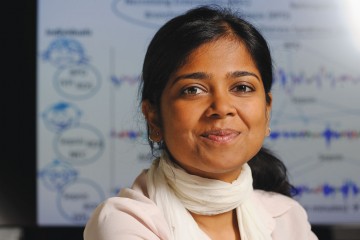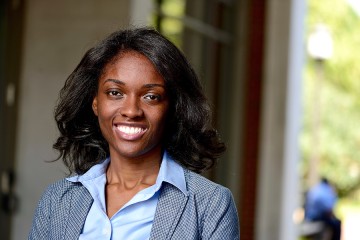Archana Venkataraman, an assistant professor in the Department of Electrical and Computer Engineering at Johns Hopkins, has been named to this year's MIT Technology Review 35 Innovators Under 35 list.
Among the award's past recipients are Larry Page and Sergey Brin, the cofounders of Google; Mark Zuckerberg, co-founder of Facebook; JB Straubel, co-founder and CTO of Tesla Motors; and Cynthia Breazel, founder of Jibo, a personal assistant robot.
"This is surreal for me," said Venkataraman, a core faculty member of the Malone Center for Engineering in Healthcare and principal investigator of the Neural Systems Analysis Laboratory. "The TR 35 list contains so many influential people who have gone on to change the world. It's an honor to be named alongside them."
Venkataraman develops new machine learning algorithms to better understand, diagnose, and treat debilitating neuropsychiatric disorders. Her algorithms blend insights from neurology and psychiatry with techniques from signal processing, probabilistic modeling, nonlinear optimization, and network theory.
Though Venkataraman's research spans a variety of disorders including autism, schizophrenia, and Alzheimer's disease, the MIT Technology Review lauded her work on detecting and pinpointing the sources of epileptic seizures in the brain as "groundbreaking."
Epilepsy affects nearly 50 million people globally, and though anti-seizure drugs are available, about 30 percent of patients do not respond to medication. If seizures can be tracked precisely to a single brain region, surgery to remove this seizure-onset zone offers patients the best chance of relief. Currently, seizure localization is done by manually inspecting electroencephalography, or EEG, and magnetic resonance imaging, or MRI, data, which is prone to human error. Her group has pioneered a seizure-tracking algorithm for EEG which beats state-of-the-art seizure detectors and can help improve manual review. In parallel, she has developed a hub-detection algorithm that identifies the seizure onset in functional MRI data and provides a new dimension to the problem.
For Venkataraman, joining this illustrious group means that her many "wacky ideas" on how to integrate machine learning and clinical neuroscience are on the right track.
"For me, there is no greater endeavor than solving a real-world problem that can ultimately improve the lives of many," said Venkataraman, whose work on neural modeling for autism also earned her an NSF CAREER Award earlier this year. "My entire research trajectory, from graduate student to faculty, has been a migration towards the clinical domain."
Posted in Science+Technology










